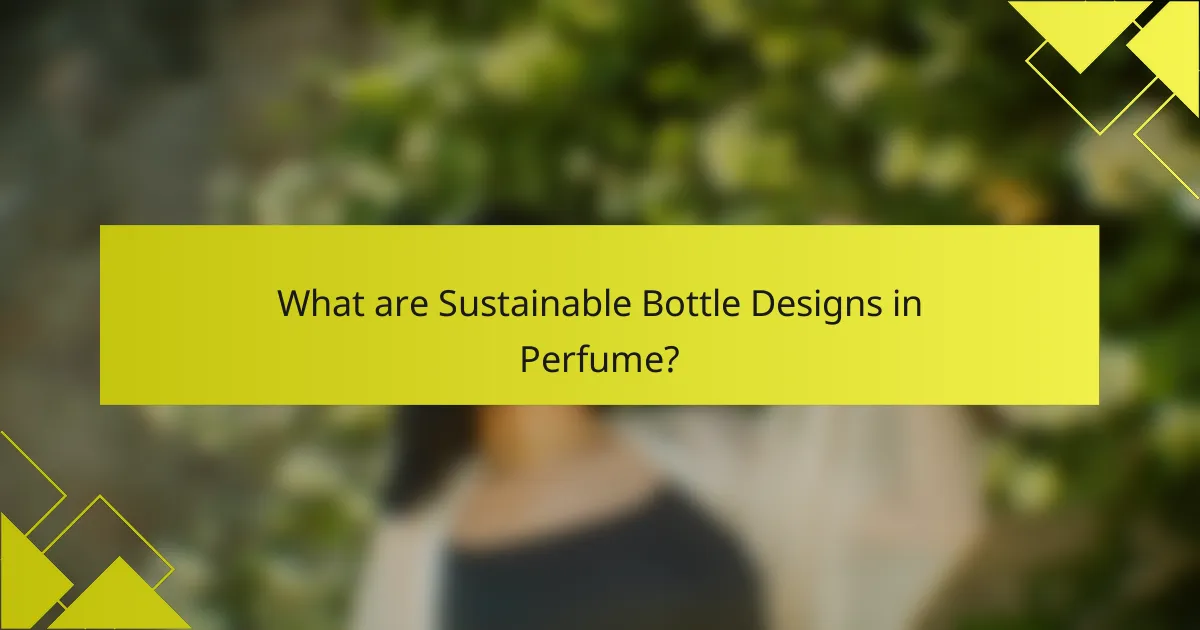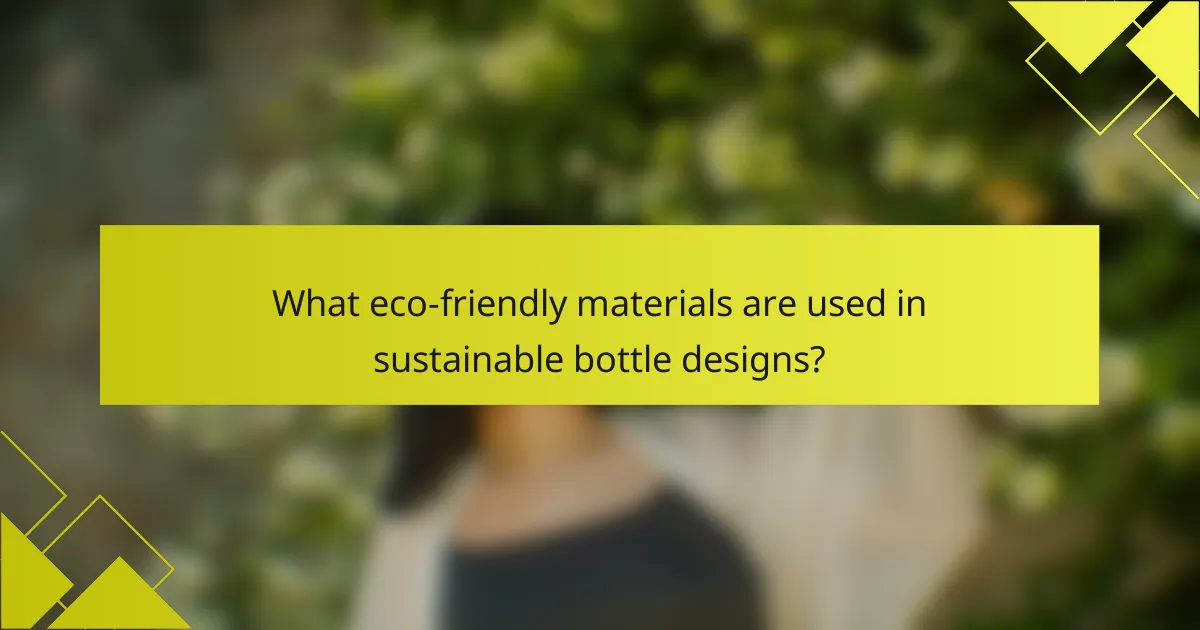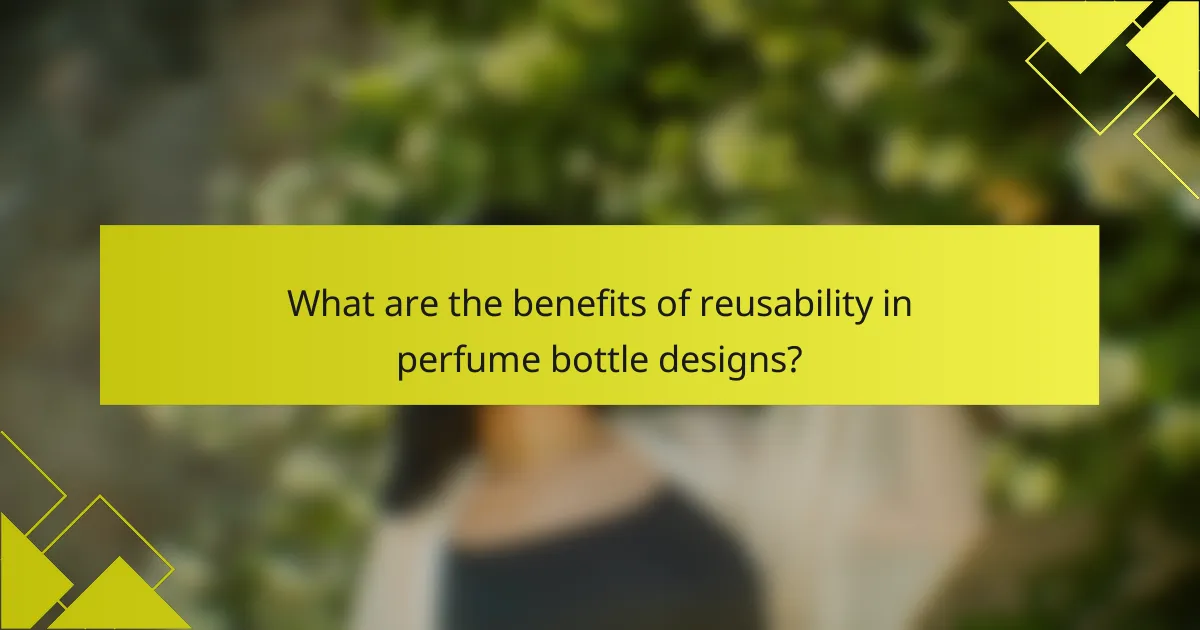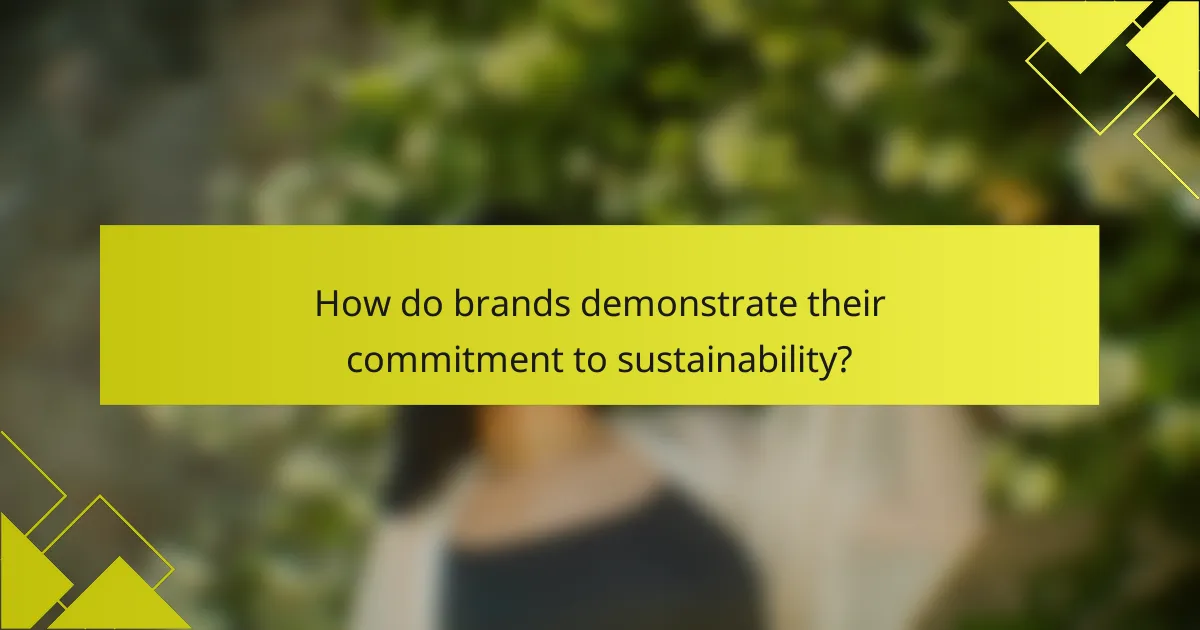
What are Sustainable Bottle Designs in Perfume?
Sustainable bottle designs in perfume are packaging solutions that minimize environmental impact. They often utilize eco-friendly materials such as recycled glass and biodegradable plastics. These designs prioritize reusability, allowing consumers to refill bottles rather than discarding them. Brands committed to sustainability may also implement innovative manufacturing processes that reduce waste. The adoption of such designs is increasingly driven by consumer demand for environmentally responsible products. Research indicates that 72% of consumers prefer brands that focus on sustainability. This trend reflects a broader commitment to reducing the carbon footprint in the fragrance industry.
How do sustainable bottle designs differ from traditional designs?
Sustainable bottle designs differ from traditional designs primarily in their materials and lifecycle impact. Sustainable designs often utilize eco-friendly materials such as recycled plastics or biodegradable substances. Traditional designs typically rely on virgin plastics or glass, which have a higher environmental footprint.
Sustainable bottles are often designed for reusability and refillability, promoting a circular economy. In contrast, traditional bottles are frequently single-use, contributing to waste.
Additionally, sustainable designs focus on minimizing energy consumption during production. Traditional designs may not prioritize energy efficiency, leading to greater resource depletion.
Research indicates that sustainable packaging can reduce carbon emissions by up to 30% compared to conventional options. This demonstrates the significant environmental benefits of adopting sustainable bottle designs.
What materials are commonly used in sustainable perfume bottles?
Sustainable perfume bottles are commonly made from materials like glass, recycled plastic, and biodegradable materials. Glass is a preferred choice due to its recyclability and inert nature. Recycled plastic helps reduce waste and energy consumption in production. Biodegradable materials, such as plant-based plastics, are gaining popularity for their lower environmental impact. These materials align with eco-friendly practices and brand commitments to sustainability.
What are the design principles behind sustainable perfume bottles?
Sustainable perfume bottles are designed based on principles that prioritize environmental impact. These principles include the use of eco-friendly materials, such as recycled glass and biodegradable plastics. Reusability is another key principle, encouraging consumers to refill bottles rather than dispose of them. Minimalist design reduces material waste while still providing aesthetic appeal. Additionally, manufacturers often focus on energy-efficient production methods to lessen carbon footprints. Transparency in sourcing materials is also emphasized to build consumer trust. Sustainable packaging often incorporates designs that are easy to transport and store, minimizing resource use. These principles collectively contribute to a more sustainable lifecycle for perfume products.
Why is sustainability important in the perfume industry?
Sustainability is important in the perfume industry to reduce environmental impact. The production of perfumes often involves the use of natural resources and chemicals that can harm ecosystems. Sustainable practices help minimize waste and pollution. For instance, using eco-friendly materials in packaging can significantly lower carbon footprints. Additionally, sustainable sourcing of ingredients ensures that biodiversity is preserved. Brands that adopt sustainability can enhance their reputation and attract environmentally conscious consumers. Research shows that 66% of global consumers are willing to pay more for sustainable brands. Thus, sustainability is not only ethical but also a competitive advantage in the market.
How does sustainability impact consumer choices in perfume?
Sustainability significantly influences consumer choices in perfume. Many consumers prefer brands that prioritize eco-friendly practices. Research shows that 66% of global consumers are willing to pay more for sustainable brands. Eco-friendly materials in packaging attract environmentally conscious buyers. Reusable bottle designs enhance brand loyalty and repeat purchases. Brands committed to sustainability often see increased customer trust. This shift reflects a growing trend towards responsible consumption in the fragrance market.
What role does sustainability play in brand reputation?
Sustainability significantly enhances brand reputation. Brands that prioritize sustainable practices are often viewed more favorably by consumers. For instance, a 2021 Nielsen report found that 81% of global respondents feel strongly that companies should help improve the environment. Sustainable practices can lead to increased customer loyalty and trust. Brands recognized for their eco-friendly initiatives often experience higher sales and market share. Additionally, sustainability can differentiate a brand in competitive markets. Consumers are more likely to support brands that align with their values regarding environmental responsibility. Therefore, sustainability plays a crucial role in shaping positive perceptions of a brand.

What eco-friendly materials are used in sustainable bottle designs?
Sustainable bottle designs often utilize eco-friendly materials such as recycled glass, biodegradable plastics, and bamboo. Recycled glass reduces energy consumption and minimizes waste. Biodegradable plastics, made from plant-based sources, break down more easily than traditional plastics. Bamboo serves as a sustainable alternative, as it grows quickly and requires minimal resources. Other materials include aluminum, which is recyclable and lightweight, and post-consumer recycled (PCR) plastics, which repurpose existing plastic waste. These materials collectively contribute to reducing environmental impact and promoting sustainability in packaging.
What are the most popular eco-friendly materials for perfume bottles?
The most popular eco-friendly materials for perfume bottles include glass, recycled plastics, and bioplastics. Glass is widely favored due to its recyclability and ability to preserve fragrance quality. Recycled plastics reduce waste by repurposing materials, making them a sustainable choice. Bioplastics, derived from renewable resources, offer an alternative that can biodegrade under specific conditions. These materials align with the growing demand for sustainability in the fragrance industry. Brands increasingly adopt these eco-friendly options to meet consumer preferences for environmentally responsible products.
How do these materials compare in terms of environmental impact?
Eco-friendly materials generally have a lower environmental impact compared to traditional materials. For instance, biodegradable plastics can decompose naturally, reducing landfill waste. In contrast, conventional plastics can take hundreds of years to break down. Recycled glass bottles require less energy to produce than new glass, minimizing carbon emissions. Additionally, materials like bamboo and metal are sustainable due to their renewability and recyclability. Studies show that using sustainable materials can reduce a product’s carbon footprint by up to 50%. Brands committed to sustainability often choose these materials to enhance their environmental responsibility.
What are the benefits of using recycled materials in bottle design?
Using recycled materials in bottle design reduces environmental impact. It minimizes waste and lowers the demand for virgin resources. This practice conserves energy, as recycling typically uses less energy than producing new materials. For example, using recycled PET can save up to 75% of the energy compared to new PET production. Additionally, it helps in reducing greenhouse gas emissions, contributing to climate change mitigation. Brands adopting recycled materials often enhance their sustainability image, appealing to eco-conscious consumers. This can lead to increased customer loyalty and market differentiation. Overall, the benefits include resource conservation, energy efficiency, emission reduction, and improved brand perception.
How do manufacturers ensure the quality of eco-friendly materials?
Manufacturers ensure the quality of eco-friendly materials through rigorous testing and certification processes. They often source materials from certified suppliers who meet environmental standards. These materials are subjected to performance tests to verify durability and safety. Manufacturers also conduct life cycle assessments to evaluate the environmental impact of materials. Regular audits and inspections are performed to maintain compliance with sustainability standards. For instance, certifications like FSC and GOTS provide assurance of eco-friendly practices. By adhering to these measures, manufacturers can guarantee the quality and sustainability of their materials.
What certifications or standards are applied to sustainable materials?
Certifications and standards applied to sustainable materials include the Forest Stewardship Council (FSC) certification, the Global Organic Textile Standard (GOTS), and the Cradle to Cradle Certified™ standard. The FSC certification ensures that materials come from responsibly managed forests. GOTS verifies organic status and environmental criteria for textiles. Cradle to Cradle Certified™ assesses the safety and circularity of materials. These certifications promote sustainability in various industries, including packaging. They provide consumers with assurance regarding the environmental impact of products.
How does the sourcing of materials affect sustainability?
The sourcing of materials significantly impacts sustainability by determining the environmental footprint of production. Sustainable sourcing involves selecting materials that are renewable, recycled, or responsibly harvested. This reduces resource depletion and minimizes pollution. For example, using recycled glass for perfume bottles lowers energy consumption compared to using new materials. Additionally, local sourcing can decrease transportation emissions. According to the Ellen MacArthur Foundation, sustainable sourcing practices can lead to a circular economy, enhancing resource efficiency. Thus, responsible material sourcing directly supports sustainability initiatives in product design and manufacturing.

What are the benefits of reusability in perfume bottle designs?
Reusability in perfume bottle designs offers environmental and economic benefits. It reduces waste by minimizing the number of bottles discarded after single use. Reusable bottles often encourage consumers to purchase refills, promoting sustainable consumption. This practice can lower production costs for brands by reducing the need for new materials. Additionally, reusable designs can enhance brand loyalty, as consumers appreciate environmentally responsible practices. A study by the Ellen MacArthur Foundation highlights that reusability can significantly decrease carbon emissions associated with packaging. Therefore, reusability in perfume bottles not only supports sustainability but also aligns with consumer values.
How can consumers benefit from reusable perfume bottles?
Consumers benefit from reusable perfume bottles by reducing waste and promoting sustainability. Reusable bottles minimize the environmental impact associated with single-use packaging. They encourage consumers to refill rather than discard, which conserves resources. Additionally, many brands offer discounts or incentives for refills, providing financial savings. Reusable bottles often feature durable designs, enhancing longevity and user satisfaction. This practice aligns with eco-conscious consumer trends, fostering a sense of responsibility. Research indicates that sustainable packaging can enhance brand loyalty, as consumers increasingly prefer eco-friendly options.
What are the most effective ways to encourage reuse among consumers?
The most effective ways to encourage reuse among consumers include implementing incentives, enhancing convenience, and educating the public. Incentives can take the form of discounts or loyalty points for returning bottles. Convenience can be improved by providing easy return options or refill stations. Education on the environmental benefits of reuse can increase consumer motivation. Research shows that consumers are more likely to reuse products when they understand the positive impact on sustainability. For instance, a study by the Ellen MacArthur Foundation reported that increased awareness of plastic pollution leads to greater consumer action towards reuse.
How do brands promote the reusability of their bottles?
Brands promote the reusability of their bottles through eco-friendly designs and consumer education. They often use materials that are durable and recyclable. Many brands offer refill programs to encourage customers to reuse bottles. These programs often provide discounts or incentives for refills. Brands also emphasize the environmental benefits of reusing bottles in their marketing. They may share statistics about waste reduction and sustainability. Collaborations with environmental organizations further enhance their commitment to reusability. Social media campaigns highlight customer stories and experiences with reusable bottles. This multifaceted approach effectively communicates the value of reusability to consumers.
What challenges do brands face in implementing reusable designs?
Brands face several challenges in implementing reusable designs. One significant challenge is the higher initial cost of production. Developing reusable bottles often requires investment in durable materials and innovative designs. Brands may also encounter consumer resistance to changing established purchasing habits. Many customers are accustomed to single-use products and may not see the value in reusable options.
Another challenge is the need for effective marketing strategies. Brands must educate consumers about the benefits of reusability and how to properly care for these products. Additionally, ensuring consistent quality and functionality in reusable designs can be difficult. Brands must balance aesthetics with practicality to meet consumer expectations.
Logistics and supply chain management also present hurdles. Brands need to establish systems for collecting, cleaning, and redistributing reusable bottles. This process can be complex and costly. Regulatory compliance is another factor, as brands must adhere to safety and environmental standards for reusable products.
Overall, these challenges require strategic planning and investment to successfully implement reusable designs in the perfume industry.
How can brands overcome obstacles related to consumer acceptance?
Brands can overcome obstacles related to consumer acceptance by prioritizing transparency and education. Clear communication about the sustainability of materials used in bottle designs can build trust. Providing information on eco-friendly practices can enhance consumer understanding. Engaging consumers through interactive campaigns fosters a sense of community. Research shows that brands demonstrating genuine commitment to sustainability see increased consumer loyalty. A study by Nielsen indicates that 66% of consumers are willing to pay more for sustainable brands. By showcasing the benefits of reusable designs, brands can appeal to environmentally conscious consumers. Highlighting certifications and third-party endorsements can further validate claims.
What innovations are being developed to enhance reusability?
Innovations enhancing reusability in sustainable perfume bottle designs include modular components and refillable systems. Modular designs allow consumers to replace only the empty part of the bottle, reducing waste. Refillable systems encourage users to purchase refills instead of new bottles, promoting long-term use. Biodegradable materials are also being developed, which can break down safely after their lifecycle. Smart technology integration enables tracking of usage, reminding consumers when to refill. These innovations align with the growing consumer demand for sustainability in packaging. Studies indicate that 70% of consumers prefer brands that offer sustainable practices.

How do brands demonstrate their commitment to sustainability?
Brands demonstrate their commitment to sustainability through various practices. They utilize eco-friendly materials in product packaging. For example, many brands use recycled glass or biodegradable plastics. Brands also implement sustainable sourcing for ingredients. This ensures that raw materials are obtained responsibly. Additionally, brands promote reusability in their packaging designs. Refillable perfume bottles are a common example. They often engage in transparent communication about their sustainability efforts. This includes publishing sustainability reports and certifications. Research shows that 66% of consumers prefer brands that are environmentally responsible. This consumer preference drives brands to adopt sustainable practices.
What practices can brands adopt to showcase their sustainability efforts?
Brands can adopt several practices to showcase their sustainability efforts. They can utilize eco-friendly materials in product packaging. This includes biodegradable or recyclable materials that reduce environmental impact. Brands can also implement a transparent supply chain. By sharing information about sourcing and production processes, they build consumer trust.
Additionally, they can promote reusability of their products. Offering refillable bottles encourages customers to reduce waste. Brands may also engage in sustainability certifications. Certifications from recognized organizations validate their commitment to eco-friendly practices.
Furthermore, brands can participate in community initiatives. Collaborating on local environmental projects demonstrates active involvement. Lastly, they should communicate their sustainability goals clearly. Regular updates through marketing channels keep consumers informed and engaged.
How does transparency in sourcing materials build consumer trust?
Transparency in sourcing materials builds consumer trust by providing clear information about product origins. When brands disclose their sourcing practices, consumers feel more informed. This openness fosters a sense of accountability and reliability. Studies show that 94% of consumers are more likely to be loyal to a brand that offers complete transparency. Furthermore, transparency can highlight ethical practices, such as fair labor and sustainable sourcing. This alignment with consumer values strengthens brand loyalty. In the context of sustainable perfume bottles, knowing the eco-friendly materials used can enhance trust. Brands that share their sourcing stories often see increased customer engagement and satisfaction.
What role does marketing play in communicating brand commitment to sustainability?
Marketing plays a crucial role in communicating a brand’s commitment to sustainability. It helps convey the brand’s values and initiatives regarding eco-friendly practices. Through targeted campaigns, brands can showcase their sustainable materials and production processes. Marketing strategies can highlight the reusability of products, reinforcing their environmental impact. For instance, brands often use storytelling to connect emotionally with consumers about sustainability efforts. Research shows that 66% of consumers are willing to pay more for sustainable brands. This demonstrates that effective marketing can influence consumer perception and purchasing decisions. By transparently sharing sustainability goals, brands build trust and loyalty among eco-conscious customers.
What are some examples of brands leading in sustainable bottle designs?
Brands leading in sustainable bottle designs include Stella McCartney, L’Occitane, and Aveda. Stella McCartney uses recycled materials for its perfume bottles. L’Occitane focuses on refillable options to reduce waste. Aveda emphasizes biodegradable packaging in its product lines. These brands demonstrate a commitment to eco-friendly practices. Their innovations reflect a growing trend in the beauty industry towards sustainability.
How do these brands differentiate themselves in the market?
Brands differentiate themselves in the market through unique sustainable bottle designs. They utilize eco-friendly materials such as recycled glass and bioplastics. This commitment to sustainability appeals to environmentally conscious consumers. Additionally, brands offer reusable bottles to promote longevity and reduce waste. Some brands emphasize innovative designs that enhance aesthetic appeal. Others focus on transparency about sourcing and production practices. This differentiation helps brands build a loyal customer base. Research indicates that 66% of consumers are willing to pay more for sustainable products.
What lessons can emerging brands learn from these examples?
Emerging brands can learn the importance of sustainability from these examples. They should prioritize eco-friendly materials in their packaging. Using recycled or biodegradable materials can enhance brand appeal. Reusability of packaging can encourage customer loyalty. Brands should communicate their sustainability efforts transparently. This builds trust and attracts environmentally conscious consumers. Additionally, aligning brand values with sustainability can differentiate them in a competitive market. Implementing these strategies can lead to long-term success and positive brand perception.
What are the best practices for consumers when choosing sustainable perfume bottles?
Consumers should prioritize eco-friendly materials when choosing sustainable perfume bottles. Look for bottles made from recycled glass or biodegradable plastics. These materials reduce environmental impact. Additionally, consider the reusability of the bottle. Refillable options promote sustainability by minimizing waste. Brands committed to sustainability often provide information about their sourcing and production practices. Researching brand transparency can guide consumers toward responsible choices. Lastly, evaluate the lifecycle of the bottle. Sustainable designs should minimize energy consumption during production and transportation.
Sustainable bottle designs in perfume focus on eco-friendly packaging solutions that minimize environmental impact through the use of materials like recycled glass and biodegradable plastics. These designs prioritize reusability and refillability, aligning with consumer demand for sustainable products. The article explores how sustainable designs differ from traditional options, the materials commonly used, and the principles guiding their development. It also highlights the importance of sustainability in the perfume industry, its influence on consumer choices, and how brands can effectively communicate their commitment to eco-friendly practices.



